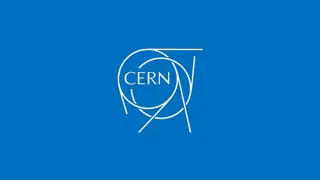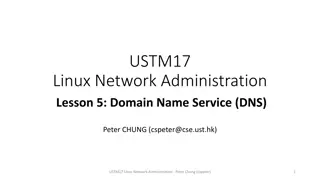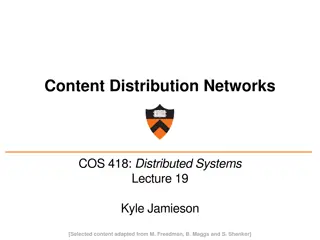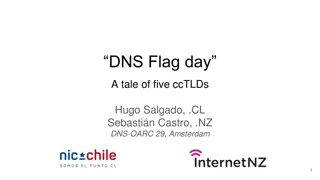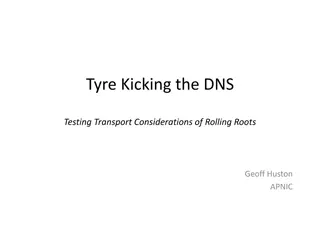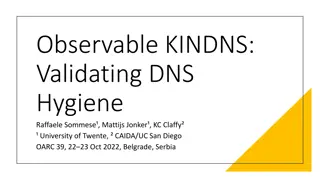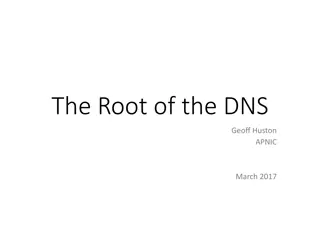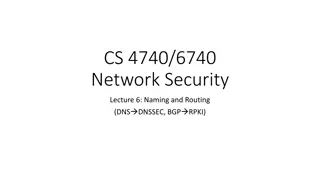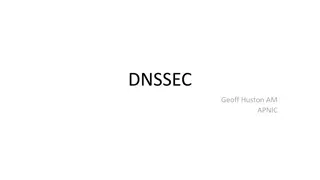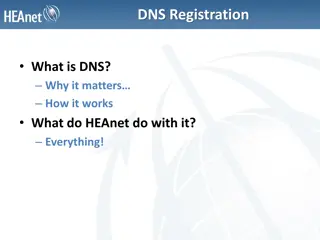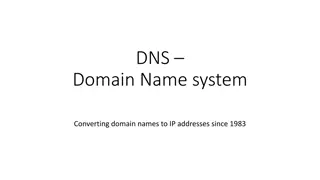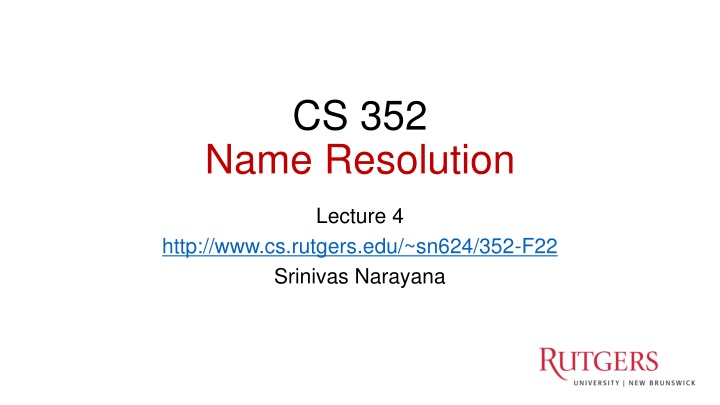
DNS Protocol and Message Format
Explore the DNS protocol, message format, client-server interaction, and the structure of distributed and hierarchical databases. Delve into concepts like domain name resolution, client-server architecture, and the scalability and security challenges associated with DNS servers.
Download Presentation

Please find below an Image/Link to download the presentation.
The content on the website is provided AS IS for your information and personal use only. It may not be sold, licensed, or shared on other websites without obtaining consent from the author. If you encounter any issues during the download, it is possible that the publisher has removed the file from their server.
You are allowed to download the files provided on this website for personal or commercial use, subject to the condition that they are used lawfully. All files are the property of their respective owners.
The content on the website is provided AS IS for your information and personal use only. It may not be sold, licensed, or shared on other websites without obtaining consent from the author.
E N D
Presentation Transcript
CS 352 Name Resolution Lecture 4 http://www.cs.rutgers.edu/~sn624/352-F22 Srinivas Narayana 1
Review of concepts Connection 4-tuple IPA DNS: turn human- readable addresses into IP addresses. IPB portB portA Application process Application process Propagation bind(IPB, portB) listen() accept() recv(data) gethostbyname() Transmission Bandwidth connect(IPB, portB) send(data) Queueing User space Socket Socket Kernel space Client-server architecture OS network stack layers OS network stack layers Peer to peer architecture Internet
DOMAIN NAME IP ADDRESS spotify.com 98.138.253.109 Simple DNS cs.rutgers.edu 128.6.4.2 www.google.com 74.125.225.243 www.princeton.edu 128.112.132.86 <Client IP, CPort, DNS server IP, 53> QUERY cs.rutgers.edu <DNS server, 53, Client IP, Cport> RESPONSE 128.6.4.2 Key idea: Implement a server that looks up a table. Will this scale? Every new (changed) host needs to be (re)entered in this table Performance: can the server serve billions of Internet users? Failure: what if the server or the database crashes? Security: What if someone takes over this server? 3
Distributed and hierarchical database Root DNS Servers Top-level domain (TLD) servers org DNS servers edu DNS servers com DNS servers umass.edu DNS servers rutgers.edu DNS servers wnyc.org DNS servers google.com DNS servers amazon.com DNS servers Authoritative name server cs.rutgers.edu DNS server Hierarchy Replication RFC 1034 4
DNS Protocol Client-server application Client connects to (known) port 53 on server For now, assume DNS server IP known Two types of messages Queries Responses Type of Query (OPCODE) Standard query (0x0) e.g., Request IP address for a given domain name Updates (0x5) Provide a binding of IP address to domain name Each type has a common message format that follows the header 5
DNS protocol: Message format DNS protocol : query and reply messages, both with same message format QR Opcode Message header QR = 0 for Query, 1 for response Opcode= 0 standard identification: 16 bit # for query, reply to query uses same # flags: Authoritative answer recursion desired recursion available reply is authoritative 6
DNS protocol: Message format QR OPCODE Name, type fields for a query Resource records in response to query records for authoritative servers Information about nameserver additional helpful info that may be used 7
DNS Protocol: Actions When client wants to know an IP address for a host name Client sends a DNS query to the local name server in its network If name server contains the mapping, it returns the IP address to the client Otherwise, the name server forwards the request to the root name server The request works its way down the DNS hierarchy until it reaches a name server with a mapping for the requested name 8
root DNS server Example 2 3 Host at cs.rutgers.edu wants IP address for gaia.cs.umass.edu .edu DNS server 4 5 local DNS server dns.rutgers.edu Local DNS server Root DNS server TLD DNS server Authoritative DNS server 6 7 1 8 umass.edu DNS server dns.umass.edu requesting host cs.rutgers.edu gaia.cs.umass.edu 9
root DNS server Query type 2 3 Iterative query .edu DNS server 4 5 Contacted server replies with name of server to contact local DNS server dns.rutgers.edu 6 7 1 8 I don t know this name, but ask this other server umass.edu DNS server dns.umass.edu requesting host cs.rutgers.edu Queries are iterative from POV of the local DNS server gaia.cs.umass.edu 10
root DNS server Query type 2 3 Recursive query: Puts burden of name resolution on the contacted (e.g., root) name server Query to root DNS server is recursive from POV of local 6 7 .edu DNS server local DNS server dns.rutgers.edu 4 5 1 8 umass.edu DNS server dns.umass.edu Problem: think about load on the root DNS server. Must it answer every DNS query? requesting host cs.rutgers.edu gaia.cs.umass.edu 11
DNS caching Once (any) name server learns a name to IP address mapping, it caches the mapping Cache entries timeout (disappear) after some time TLD servers typically cached in local name servers In practice, root name servers aren t visited often! Caching is pervasive in DNS 12
DNS in action dig <domain-name> dig +trace <domain-name> dig @<dns-server> <domain-name> Don t just watch; try it!
Bootstrapping DNS How does a host contact the name server if all it has is the domain name and no (name server) IP address? IP address of at least 1 nameserver (usually, a local resolver) must be known a priori The name server may be bootstrapped statically , e.g., File /etc/resolv.conf in unix Start -> settings-> control panel-> network ->TCP/IP -> properties in windows or with another protocol! DHCP: Dynamic Host Configuration Protocol (more on this later) 14
DNS is a distributed database DNS stores resource records (RRs) (Incomplete) message format for each resource record (RR): Class, type, name, value, TTL You can read all the gory details of the message format at https://www.iana.org/assignments/dns-parameters/dns- parameters.xhtml
DNS records Type=A name is hostname value is IPv4 address Type=CNAME name is alias name for some canonical (the real) name e.g., www.ibm.com is really servereast.backup2.ibm.com value is canonical name Type=AAAA name is hostname value is IPv6 address Type=NS name is domain (e.g. foo.com) value is hostname of authoritative name server for this domain Type=MX value is name of mailserver associated with name More complete info at https://www.iana.org/assignments/dns-parameters/dns-parameters.xhtml 18
DNS record example NAME Design.cs.rutgers.edu RRs in response TYPE A to query CLASS IN TTL 1 day(86400) ADDRESS 192.26.92.30 NAME Cs.rutgers.edu records for authoritative servers Information about nameserver TYPE NS CLASS IN TTL 1 day(86400) NSDNAME Ns-lcsr.rutgers.edu DNS serves as a general repository of information for the Internet! 19
DNS record types dig t <type> <domain-name>
Summary of DNS Hostname to IP address translation via a global network of servers Embodies several scaling principles Partition through a hierarchy to silo query load Replication to scale out at each level of hierarchy Caching to reduce query load Once you have a reliable DB, can implement many useful things on top! Example 1: Scaling large web services, e.g., google search, by redirecting different clients to different servers (IP addresses) Reliability, load balancing, performance optimization Example 2: Associating certificates, keys (security info) with domain names https://www.rfc-editor.org/rfc/rfc8162.html https://datatracker.ietf.org/doc/draft-ietf-dnsop-svcb-https/00/ 21

